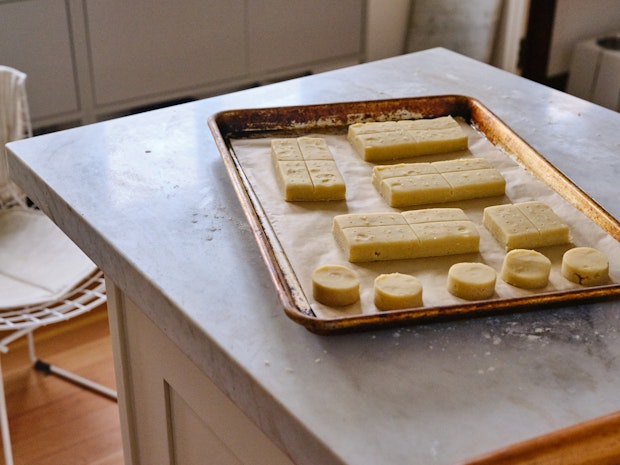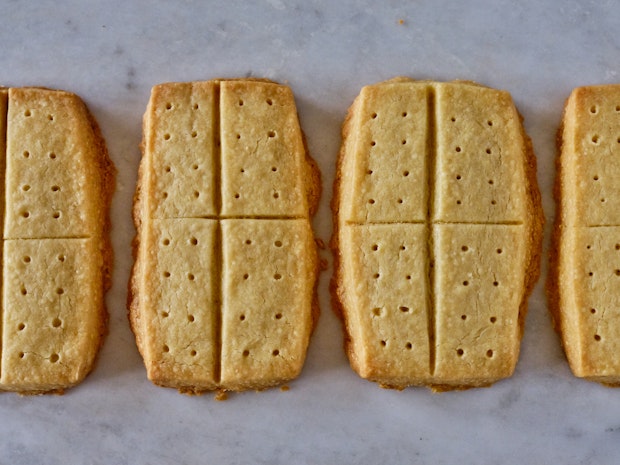Classic Shortbread Cookies
Buttery, golden, classic shortbread cookies. So simple, and the best cookies on any cookie plate.

Shortbread cookies were my first baking love. They were the first cookie I remember putting in the oven myself, always for the holidays, always wearing a kid-sized apron. I’ve developed some strong opinions on the shortbread front over the years, and I’m going to talk you through the difference between great shortbread cookies and the ones that are just so-so. Shortbread cookies can be the best cookie on any cookie tray (controversial take, I know!), and this post will walk you through how. I've featured shortbread many different ways on the site over the years, but love circling back to this buttery, golden, classic shortbread version. 
The Secret to Great Shortbread Cookies
I should say secrets, plural, because there are actually a few that will help bump your shortbread game from good to great.
- Salt: Let’s start with this, it’s an easy one. A lot of shortbread cookie recipes are under salted, and that can leave them tasting flat and boring. Others call for salted butter which can be great, but it’s harder to control seasoning levels. I’m not saying go wild on the salt front, but treat it like a pillar ingredient. It is the ingredient that will bring the toasted butter, sugar, and flour into perfect focus.
- Thickness: For classic shortbread cookies like these, I like to go thick. I’ve found that rolling out the dough to 1/2-inch thickness is too thin, and a full-inch is too thick. I aim for somewhere in the 3/4-inch zone. This allows for golden crust with crisp buttery edge and a tender center.

- Baking Time: I’ve provided guidance in the recipe for baking time, but in reality it’s all about having an eagle eye and good nose here. Use your sight and smell. A lot of the shortbread I’ve come across over the years is too pale, nearly white. That’s not what I’m after. Shortbread that is allowed to get tip top super-golden and toasted where it touches the baking pan, with a wash of color over the rest of the cookie is so much better. That’s how all the flavor comes to life. It’s literally the difference between butter and brown butter. Patience and attentiveness pays off here. Hover near the oven, let your shortbread get toasty.

Ingredients in Shortbread Cookies
Shortbread magic happens when butter, sugar, flour, and salt come together. The list of ingredients is incredibly short, so you want to make sure each one is on point. Be sure your butter is good-quality, and recently purchased. You don’t want the butter picking up refrigerator odors. When in doubt, taste. I also like to use a fresh bag of all purpose flour when baking shortbread, some flours can pick up off smells and flavors when they’ve been sitting around too long. I'm also a purist when it comes to shortbread and skip the vanilla extract you might see in other recipes.
Make-Ahead Shortbread Cookies
The freezer is your friend here and shortbread dough stored in an airtight container or double wrapped in plastic can last frozen for months. You can freeze the cookie dough pre-rollout or proceed through the cutout phase. Once you’ve rolled and cut your dough, transfer the unbaked cookies onto a parchment paper lined baking sheet and freeze before transferring to an air-tight container. Freeze until ready to bake.
Thick or Thin?
We talked a bit about this up above, but I have a few other things to say. When it comes to classic shortbread cookies, I lean towards thick. On the other hand, if I’ve loaded the dough up with zest, nuts, spices, or other flavors, I tend to use a rolling pin to roll the dough out a bit more thinly, cutting the cookies smaller for a more concentrated experience. All of this is personal preference, of course. One thing to think about here is oven temperature. For thicker shortbread, starting with a slightly hotter oven to set the dough, and then dialing it back a bit can help prevent spread. And with smaller, thinner shortbread you don’t have to worry about that as much. When in doubt, just keep an eye on things!
How do I keep my Shortbread from Spreading?
If you look at the photos above you can see the difference between properly chilled shortbread dough prior to baking (circles), and dough that wasn’t chilled long enough (rectangles). The circles had their shape perfectly while the larger rectangular slabs had a bit of spread. Another hour in the refrigerator or baking straight from the freezer will likely fix that. If you’re still getting too much spread, reduce the time you’re creaming the butter and sugars, too much air being incorporated into the dough can also cause your cookies to spread. Last, confirm your oven temperature is correct, if it is running low, you’re going to have trouble.
Other Shortbread Cookie Ideas
Once you have a shortbread recipe you love in your back pocket (hopefully this one!), you can play around with many variables. They're great for Christmas and beyond.
- Skillet Shortbread: bake directly into a cast iron skillet or press the dough into a pan, marking with fork tines, then bake. In either case, mark the top of the dough with fork tines, to ensure more even baking.
- Try Alternative Flours: If you want to introduce other flours to this recipe go for it. I’d start with 20% and make note from there. Rye flour is always a great starting point, oat flour might be nice, or buckwheat flour. I’m also curious about introducing a percentage of something like almond flour but haven’t experimented with that yet. All would add dimension and depth.
- Sugar Crust: A lot of people love it when you sprinkle large-grain sugar across the shortbread dough before baking. You end up with a crunchy sugar crust and some sparkle.
More Shortbread!
I’ve baked and highlighted many shortbread cookies over years and learned a lot. The Rose Shortbread Cookies and Toasted Almond Sables are my favorites in the beyond-classic category, but they all are special in one way or another.
Middle Eastern Millionaire's Shortbread: This is the Middle Eastern Millionaire's Shortbread from Yotam Ottolenghi and Helen Goh's Sweet. It's incredible for a number of reasons. Imagine a crisp, shortbread base spread thick with a creamy tahini-halva blend, finished with glossy tahini caramel. It's brilliant, and a thin slice makes for the perfect treat.
Rose Shortbread Cookies: One of my favorites. Classic, buttery, whole wheat shortbread cookies fragrant with rosewater, flecked with toasted nuts, and dried rose petals. They have a crunchy dusting of sugar on top that provides a satisfying, sweet tongue scratch, and are punctuated with black sesame. They are the prettiest of the shortbread lot.
Toasted Almond Sable Cookies // Toasty, nutty sable cookies made with whole wheat flour, sliced almonds, currents and salted butter. They are a take-off on Alice Medrich's charming Whole Wheat Sables, published in her book Pure Dessert.
There's also Apple & Carrot Shortbread, Hearst Castle Shortbread Cookies, Pine Nut Rosemary Shortbread Cookies, and Olive Biscuit Cookies.
More Cookie Recipes
- Chocolate Cookies
- Snickerdoodles
- Triple Ginger Cookies
- David Lebovitz’s Great Chocolate Chip Cookies
- The World’s Best Cookies
- all cookie recipes
And, beyond that, here are all the baking recipes. Happy baking everyone!
Classic Shortbread Cookies
You can also press this dough into a skillet to bake, or press into a tart pan, score and bake as one continuous slab shortbread.
- 1 lb. cold unsalted butter, sliced
- 1/2 cup / 100 g sugar
- 1/2 cup / 65 g powdered sugar
- 1 1/4 teaspoon fine grain sea salt
- 4 cups / 500g unbleached all-purposed flour
-
In the bowl of a stand mixer with a paddle attachment, cream the butter until soft. Add the sugars and salt, and continue to mix until the texture is billowy and fluffy. Scrape down the bowl once or twice along the way.
-
Add the flour in two additions, mixing on low until just combined. Turn out onto the countertop, form a uniform ball and press into a thick disc shape. Wrap in plastic and refrigerate until completely chilled – at least a couple of hours. You can also freeze the dough at this point for later use.
-
Heat the oven to 350F with a rack in the center. Roll the dough out 3/4-inch thick and use a cookie cutter or knife to create as many cookies as possible. Gather any scraps, form a ball, re-roll and cut out remaining cookies. If you’re making larger cookies, use a fork or skewer to poke dots across the tops of the cookies. Arrange an inch apart on parchment-lined baking sheet. Return the cookies to refrigerator, on the pan, for another 15-30 minutes. This will help reduce spread.
-
Bake for 20 minutes, rotate the pan, and bake for another 10-15 minutes or until the cookies are deeply golden where they touch the pan, and lightly golden on top. They should smell toast and amazing!
-
Remove from the oven, allow to cool for 5 minutes, and transfer to a wire rack.
Makes 2-3 dozen medium cookies.







Post Your Comment
Comments
Greetings and thank you for being such a reliable and creative resource. You have been a part of our household culinary archives for a long time and we are most appreciative.
This year I am making batches of both your classic shortbread cookies and the triple ginger cookies as Christmas gifts. Any suggestions on storing the already baked cookies?
Thank you kindly,
Laura Ann and Michael
Hi Laura Ann and Michael – thanks for the note. So happy to be part of your cookie offerings this year. To store, I’d bake them, allow to cool completely, then store in an air-tight container until you’re ready to pack up your gifts. – h
I would like to recommend an additional variation, herbed shortbread. Just include a bit of savory herbs. Suprisingly delicious.
Love this idea Tim!
Dear Ms. Swenson,
Can I substitute brown sugar for the powdered sugar?
Thank,
Roxane Rosalinda Marek
Hi Roxane – not a straight swap, but you could experiment with amounts.
Hi! Can you refrigerate the dough over night or should it head to the freezer after 2 hours? Thanks
Are baking instructions there same if you use a tart pan?
Hi Nancy, it depends on what size tart pan you use, but you’re still looking for similar color and doneness indicators. Aim to have the shortbread a similar thickness. -h
More Recipes
Weekly recipes and inspirations.
Popular Ingredients